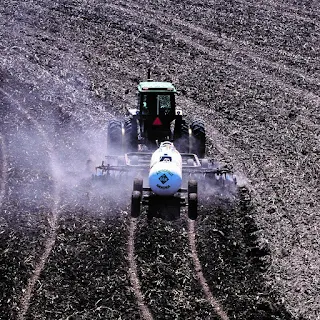By: Fabian Fernandez, Extension nitrogen management specialist
Nitrogen is the nutrient most often deficient for crop production in Minnesota, and its use can result in substantial economic return for farmers. However, when nitrogen inputs exceed crop needs, excessive amounts of nitrate can enter either ground or surface water. By effectively managing nitrogen, growers can produce crops in a more profitable and environmentally-friendly way.
There are many nitrogen fertilizers available on the marketplace, but the three most popular in Minnesota are urea, anhydrous ammonia, and urea ammonium nitrate.
Urea - CO(NH2)2
Urea is the most commonly used nitrogen fertilizer in Minnesota. It is easy to use and transport, and is 46 percent nitrogen, all in the urea form. Urea is very soluble and moves in the soil in any direction water moves.After application in the soil, the NH2 in urea changes to ammonia, either chemically or by the enzyme urease, and then to ammonium.
The potential for volatilization loss is high with urea if it is not incorporated quickly after surface application. Volatilization can reduce growers’ bottom line and harm the environment. Loss is less likely with winter or early spring applications, but results show that the loss may be substantial if the materials remain on the surface of the soil for several days. Considerable crop residue can also cause volatilization due to the presence of urease in the residue.
Volatilization can be minimized by incorporating the urea three to four inches below the soil surface within a few days of application, either with tillage or rain. Typically, a quarter to a half-inch of rain is needed to move urea down three inches. If urea cannot be incorporated by tillage, it is a good idea to use a urease inhibitor to buy more time for the application to be incorporated by rain. Keep in mind that urease inhibitors typically only last around 10 days before deteriorating.
 Anhydrous ammonia - NH3
Anhydrous ammonia - NH3
Anhydrous ammonia, NH3, is typically among the least expensive sources of nitrogen and contains 82 percent nitrogen by weight, the highest of all available sources. Anhydrous ammonia is a liquid when kept under pressure, but turns into a gas when not contained. One of the drawbacks with anhydrous ammonia is the potential danger it poses to operators and living organisms in the event it escapes into the air. It requires equipment that can handle high pressure, approximately 200 PSI, and its safe transport and handling are very important.
Because ammonia under pressure is a mixture of liquid and vapor, it is more difficult to ensure uniform application across a toolbar. Average rates can usually be attained, but distribution is affected by such things as hose length and air temperatures. These problems can be minimized by using speed-control devices, using newer manifolds that are designed to distribute ammonia more evenly, and taking time to ensure that the applicator is properly configured.
UAN - urea-ammonium nitrate
Urea-ammonium nitrate, or UAN, is available at two levels: 28 percent nitrogen and 32 percent nitrogen. UA contains 50 percent urea, 25 percent ammonium, and 25 percent nitrate. It is often dribbled or sprayed on the soil surface, but it can also be injected below the soil surface.The urea portion of UAN will undergo the same reactions as urea-based fertilizers, but since urea is only half of the total material, the potential for volatilization loss is less. Injection below the soil surface is the most effective way to minimize volatilization losses.
Because Minnesota has such diverse soils and climate, nitrogen cycle interpretations should be site-specific.
Additional resources:
- U of M nitrogen guidelines
- Video: Fall vs spring urea
- Blog post: Are controlled-release nitrogen fertilizer products worth the cost?
- Interactive tool: Explore an on-farm corn research plot studying nitrogen economics in Minnesota
- Blog post: Should corn growers adjust nitrogen applications to account for low residual nitrate levels?
- Podcast episode: Nitrogen management lessons from a wet 2019
- Blog post: Is managing nitrogen fertilizer for corn getting more difficult?
- Online course: Nitrogen Smart
For the latest nutrient management information, subscribe to Minnesota Crop News email alerts, like UMN Extension Nutrient Management on Facebook, follow us on Twitter, and visit our website.
Support for Minnesota Crop News nutrient management videos is provided in part by the Agricultural Fertilizer Research & Education Council (AFREC).
This article was first published in May 2020.


Comments
Post a Comment